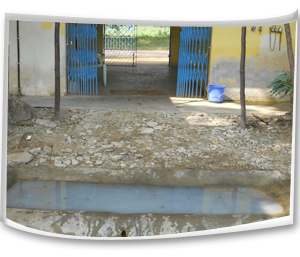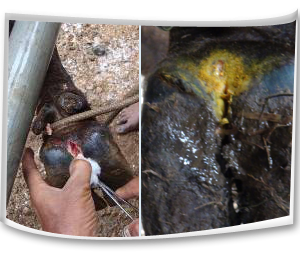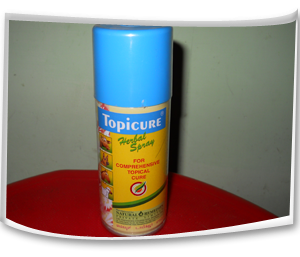|
Foot and Mouth Disease
| Nature of disease |
|
- This is a highly infectious viral disease of farm animals.
- This disease mostly manifests the lesions in the mouth, feet and mammary gland.
- Milk yield drops dramatically in milking animals, suckling calf usually die and pregnant animals may abort and infertility may ensure following abortion.
|
| Causes |
|
- It is caused by a virus Apthous of the family Picornaviridae.
- It has seven immunologically distinct serotypes namely O, A, C, Asia1, SAT1, SAT2, SAT3.
- The virus is quickly inactivated outside the pH range of 6.0 - 9.0 and by desiccation and temperature more than 56˙C, although virus may survive a considerable time when associated with animal protein such as in infected milk the virus will survive pasteurization at 72˙ C for 15 seconds.
- The virus is resistant to alcohol, ether and chloroform.
|
 |
| Mode of Transmission |
|
- Generally by direct or indirect contacts between susceptible and infected animals.
- Through movement of clinically affected animals.
- Through inanimate vectors such as vehicles, fodders, utensils, equipments etc.,
- Through air. Infected animals have a large amount of aerosol virus in their exhaled air, which can infect other animals via the respiratory or oral routes. The virus can travel up to 60 km overland and 300 km by sea.
- All secretions and excretions from the infected animal such as saliva, faeces and urine. The virus may be present in milk and semen for up to 4 days before clinical signs appear.
- The disease has been transmitted to calves via infected milk.
- This virus can survive in dry fecal material for 14 days in summer, in slurry up to 6 months in winter, in urine for 39 days and on the soil between 3 (summer) and 28 days (winter).
- By consumption of infected meat and meat by-products, unprocessed and uncooked milk.
- Through animal handlers, visitors and physicians.
- Most of the animals remain as a carrier following recovery after infection. Carrier may transfer the virus from one animal to another. Carrier cattle may harbor the virus in the esophageal-pharyngeal fluid for 6-24 months.
|
|
 |
| Clinical symptoms |
|
 |
- High fever up to 104-106˙F (41˙C) and anorexia.
- Profuse salivation (saliva hanging in long ropy strings up to the ground).
- Animal stamps its feet and wounds in the interdigital space of legs followed by lameness.
- Oral ulcers and lesions.
- Smacking of lips.
- Vesicles in the mammary gland.
|
 |
|
 |
| Preventive measures |
|
- Regular vaccination of farm animals, first dose at 3 months of age, followed by second dose at 30 days after first vaccination. Then repeated once in 6 months interval preferably during April- May.
- Vaccination of all the animals of an area/village is to be done at one time.
- Ring vaccination may be followed for control of disease outbreak and border vaccinations to protect disease free zones.
- Only vaccinated animals should be brought into the village from outside sources that too only 15-21 days following vaccination.
- No purchase of animals from disease prevailing areas.
- New animals should not be purchased until six months following outbreak.
- Unvaccinated animals should not be allowed to cattle fairs.
- Strict quarantine measures for newly purchased animals.
- A foot bath or truck bath may be made at the entrance of the village/farm.
- Always prefer to purchase / procure fodder from a place where FMD has not been recorded for a period of six months or so.
|
 |

|
| |
Suggested first aid |
- Separation of affected animals from other animals.
- Mouth and feet of the affected animals should be washed with 1% potassium permanganate (KMnO4) antiseptic mouth wash3-4 times a day.
- Glycerin may be applied over the lesions.
- Antibiotic treatment and consultation should be made with qualified veterinary Doctor.
|
| Control measures |
|
- Isolation and confinement of affected animals immediately after detection of clinical symptoms and restriction of animal movements.
- Infected animals should not be allowed to graze in common grazing pasture.
- Affected animals should not be allowed to drink water from ponds/streams/ rivers etc.
- Diseased animals should not be allowed to roam about with other animals of the village.
- Diseased animal handlers and attendants movements should be restricted to the other animal population / farms. If it is not practicable, people should scrub themselves and their belongings with soap and caustic soda.
- In case of outbreaks, healthy animals should be attended first and then the affected ones. After attending the sick animals, persons should wash himself and his clothes with 4% sodium carbonate solution. Utensils used for collecting milk should be cleaned with 4% sodium carbonate solution.
- Calves should not be allowed to suckle affected mothers and they should not be fed with milk from affected animals.
- Mouth of the affected animals may be washed with antiseptic mouth wash. 1% potassium permanganate solution may be applied 3-4 times a day.
- Feet of the affected animals may be washed with 2% copper sulphate solution. Antiseptic lotion and fly repellents are to be used to avoid infection and maggot formation on the wound.
- Disinfection of floors, premises and all infected materials by using Sodium hydroxide (2%), sodium carbonate (4%) and citric acid (0.2%) is advisable.
- Lime powder should be sprinkled around the animal houses.
- Foot bath should be made at the entrance of the farm.
|

|
 |
|
 |
|